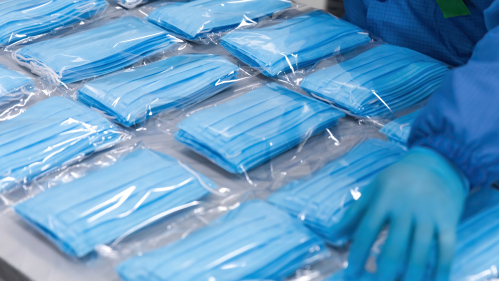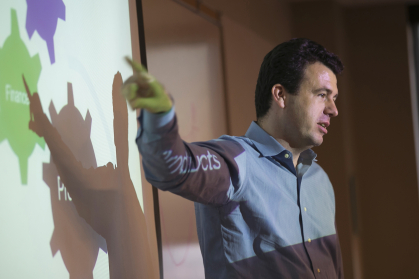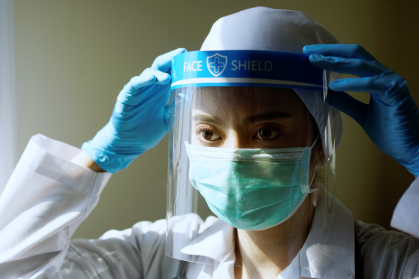In Short Supply

As COVID-19 gripped the United States, consumers and businesses faced something unprecedented for many Americans: widespread product unavailability. For those accustomed to shopping amid fully stocked shelves and receiving next-day delivery of just about anything, the shortages were a lesson in supply and demand. Consumer goods such as toilet paper, paper towels, hand sanitizer, and disinfectant wipes were scarce or being sold at exorbitant prices. For businesses in the health care sector, demand for personal protective equipment (PPE) like disposable gloves, gowns, and masks exceeded supply. Stories of hospital workers having to ration and reuse PPE were common in the early days of the pandemic.

The science of how a product goes from idea to the hands of the consumer is the essence of supply chain management, and Rutgers Business School–Newark and New Brunswick (RBS) is home to one of the largest and most highly ranked programs in the nation. Rutgers Magazine spoke with Rudolf Leuschner, associate professor of supply chain management and director of the master of science in supply chain management program at RBS, about how the COVID-19 pandemic affected supply chains, access to PPE, and more.
RUTGERS MAGAZINE: What does it take for PPE or consumer products to get sourced, manufactured, and then shipped and stocked where they are needed?
RUDOLF LEUSCHNER: Each company’s supply chain looks different, even for the same product. In general, it depends on three areas. Raw materials: companies must decide which suppliers to use. Manufacturing: can plants make enough of these products and is labor available to produce it? Logistics: can raw materials be stored in warehouses and distribution centers and then shipped to customers? Can the logistics network, comprising inventory across physical facilities, workers, and transportation equipment, cope with the new output?
RM: How is supply chain management taught at Rutgers?
RL: Most companies address these key activities: plan, source, make, deliver, and return. The host of classes cover considerations such as demand management, procurement, operations analysis, logistics, and many others. We are evaluating the challenge for businesses to create a cohesive network of companies that work together to ensure that products get to market.
RM: Significant shortages of PPE developed as the COVID-19 crisis struck. Although supply eventually did increase, there are still shortages. What did the supply chain look like before the pandemic?
RL: PPE represents a couple hundred distinct products and each product has its own supply chain. The demand and consumption for these types of products have been historically very steady. Because of that stability and the low margins of profit, the design of the supply chain has been driven by cost effectiveness and efficiency. Those supply chains, unlike, say, a fashion supply chain, do not respond well to abrupt changes.
Companies have been challenged to reconfigure production lines to produce more product as needed for the short term. But this will not change anything significantly in the long term. What some people call “the new normal” is not going to be normal one, two, or three years from now.

RM: So, even with the best of intentions, meeting the demand for PPE and other medical supplies would have been a challenge?
RL: I don’t think that the reaction could have been better; this is almost the best that we could have done. The demand we have seen has way outstripped production capacity. It’s been impressive how big the need has been. People may think otherwise, but the challenges that we have faced, and still are facing, are so great that no one charged with overseeing the whole thing could have done much better. It is so difficult to get these things going. Amazon, the world’s best retailer in logistical execution, has been struggling to fill its orders. Government execution is going to lag significantly behind that.
RM: Was the pandemic a 100-year-flood-type scenario that businesses never could have predicted or never could have prepared for?
RL: These types of events are usually not easy to prepare for, and it is often not clear how it will play out. If, for example, we had used the playbook for the 1918 flu pandemic, we would have discounted the effect of technology, which has allowed us to work and learn from home, for instance. Although there are “experts” saying every year that a pandemic is imminent, producers can’t really take action on these predictions. We cannot afford to operate a supply chain as if a pandemic or other disaster was always imminent. That would be very inefficient.
RM: At times we saw the private sector leading the way during the pandemic when the federal government was not clearly communicating. When we look at how a nation responds to a disaster, what is the best way for businesses to contribute?
RL: If businesses are integrated in responding to a disaster, the recovery goes better. I wouldn’t look at it so much from a perspective of leadership, but from the perspective that everyone has a role to play. Businesses have advantages over the government in being able to quickly make changes to current practices: enforcing mask-wearing in stores; exploring new opportunities; setting up testing sites; or using their supply chains to serve the greater good, such as Amazon prioritizing the health care industry. The only area in which the government can match businesses would probably be in using the military to set up hospitals. Otherwise, there is a big role for businesses to play.
RM: How would you design a course to evaluate the pandemic and how players responded to it?
RL: We have taught the course “Risk and Disruption Management” in the master of science in supply chain management program for about five years. Although we couldn’t specifically anticipate the pandemic, it is important for professionals to understand how disruptions affect the supply chain.